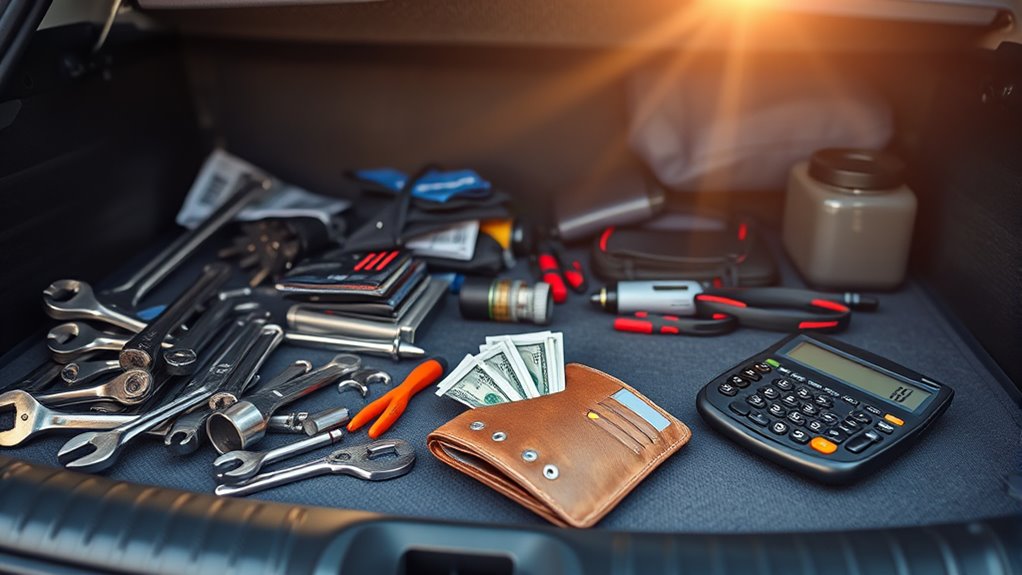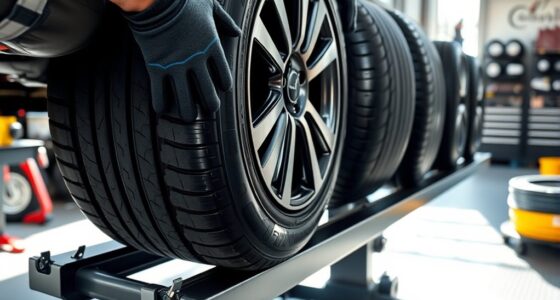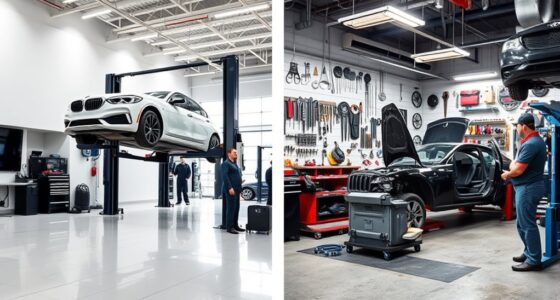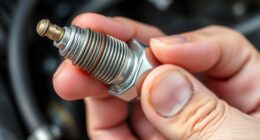To budget for major car repairs, start by understanding your insurance coverage and consider adding warranties or service plans for extra protection. Build an emergency fund specifically for unexpected expenses, and create a dedicated savings account to keep funds accessible. Keep up with routine maintenance to prevent costly issues, and compare repair costs to find affordable options. If you want simple strategies to manage repair expenses effectively, there’s more to discover below.
Key Takeaways
- Set aside a dedicated emergency fund specifically for unexpected major repairs.
- Include regular maintenance costs in your budget to prevent costly breakdowns.
- Research and compare warranty options to reduce out-of-pocket expenses for large repairs.
- Track repair and maintenance expenses to adjust your savings and planning over time.
- Prioritize preventive maintenance to minimize the likelihood of expensive future repairs.
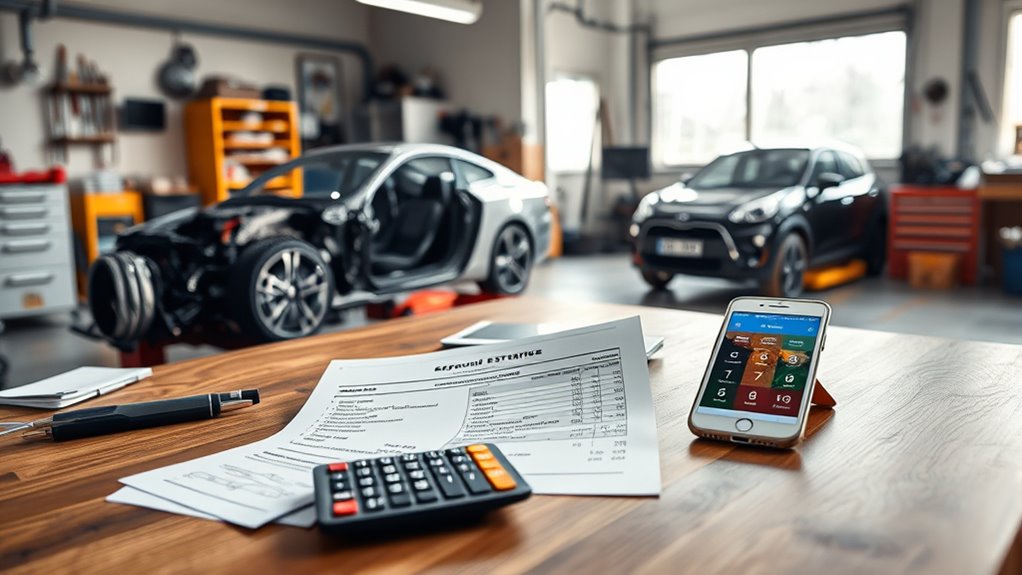
Have you ever been caught off guard by unexpected car repairs? It’s frustrating to discover that your vehicle needs costly fixes when you least expect it. To avoid the financial shock, it’s essential to plan ahead and build a budget dedicated to these inevitable expenses. One of the first steps is understanding how insurance premiums can impact your overall costs. While regular insurance helps cover accidents and theft, it often doesn’t pay for repairs resulting from wear and tear or mechanical failure. That’s why exploring warranty options is a smart move. Extended warranties or service plans can provide peace of mind by covering major repairs after your vehicle’s manufacturer warranty expires. They might seem like an upfront expense, but they can save you a significant amount of money in the long run, especially if your car develops a serious issue.
Planning for unexpected car repairs and exploring warranty options can save you money and reduce stress.
When budgeting for repairs, think about setting aside a specific emergency fund. Even if you have insurance and warranty coverage, not all repairs are fully covered. Deductibles, exclusions, and limits can leave you responsible for some costs. Having a dedicated savings account ensures you’re prepared for these out-of-pocket expenses without disrupting your monthly finances. Aim to stash away at least a few hundred dollars a year, gradually increasing your fund as your car ages or if you drive extensively. This way, when a major repair arises, you won’t have to scramble for funds or resort to high-interest loans. Building an emergency fund is a crucial part of managing unexpected expenses and maintaining financial stability.
Another aspect to take into account is preventive maintenance, which can save you money in the long run. Regular oil changes, tire rotations, brake inspections, and fluid checks help prevent major issues. Keeping up with these routine services reduces the likelihood of costly repairs down the road. When it’s time for maintenance, factor those costs into your overall budget. Being proactive can extend the lifespan of your vehicle and minimize surprises.
Additionally, shop around for repair shops and parts. Prices can vary widely, and some mechanics offer discounts or payment plans. If you’re comfortable with DIY projects, learning basic repairs can also cut costs. Just make sure you have the right tools and knowledge to avoid causing further damage. Remember, planning for these expenses isn’t about avoiding repairs but about managing them smartly so they don’t derail your finances. By understanding your insurance options, exploring warranty plans, and setting aside a dedicated savings buffer, you can face major car repairs with confidence, knowing you’re financially prepared. Incorporating financial planning strategies can further help you manage these expenses effectively.
Frequently Asked Questions
How Do I Estimate Unexpected Repair Costs Accurately?
To estimate unexpected repair costs accurately, start by reviewing your car’s maintenance schedule and noting common issues. Add a buffer for unexpected expenses, considering insurance costs that might cover some repairs. Keep track of past repairs to identify patterns. Regularly set aside a portion of your budget specifically for emergencies, ensuring you’re prepared without stressing your finances when surprise repairs happen.
Should I Set Aside a Separate Emergency Fund for Car Repairs?
Think of your emergency fund as a safety net woven just for your car maintenance needs. Yes, you should set aside a separate fund for car repairs, giving you peace of mind when unexpected issues arise. Rely on your insurance coverage for major accidents, but your dedicated savings will handle those surprise repairs insurance doesn’t cover. This way, you’re prepared, resilient, and ready to keep your vehicle running smoothly.
How Often Should I Review and Adjust My Repair Budget?
You should review and adjust your repair budget at least every six months or after any significant maintenance or warranty coverage changes. Regularly update your maintenance schedule to reflect upcoming services, and factor in warranty coverage to avoid unnecessary expenses. Staying proactive helps you catch potential issues early, ensuring your budget remains realistic and prepared for unexpected repairs or service needs, keeping your car running smoothly and financially secure.
What Are the Best Savings Strategies for Large Repairs?
To save for large repairs, focus on maintenance planning and build a dedicated emergency fund. Prioritize regular maintenance to prevent costly breakdowns. Consider increasing your savings gradually, setting aside a fixed amount each month. Check if your insurance coverage includes repairs or roadside assistance, which can help reduce out-of-pocket costs. Automate your savings to stay consistent and review your budget periodically to adjust for upcoming repairs or changes in coverage.
How Can I Prioritize Repairs When Funds Are Limited?
When funds are limited, you should prioritize repairs based on safety and criticality, referring to your maintenance checklist and service schedule. Tackle urgent issues like brake or engine problems first, then address less critical repairs later. Regularly reviewing your maintenance checklist helps you stay on top of essential services, preventing small issues from becoming costly emergencies. This approach guarantees your vehicle remains safe and reliable without straining your budget.
Conclusion
Budgeting for major car repairs might seem intimidating, but with careful planning, it becomes second nature—almost like a coincidence. When you set aside a little each month, you’re naturally prepared for unexpected costs. Over time, this habit aligns seamlessly with your financial goals, proving that good preparation often happens when you least expect it. So, stay consistent; the peace of mind you gain is worth every effort, turning surprise repairs into just another manageable part of your journey.
